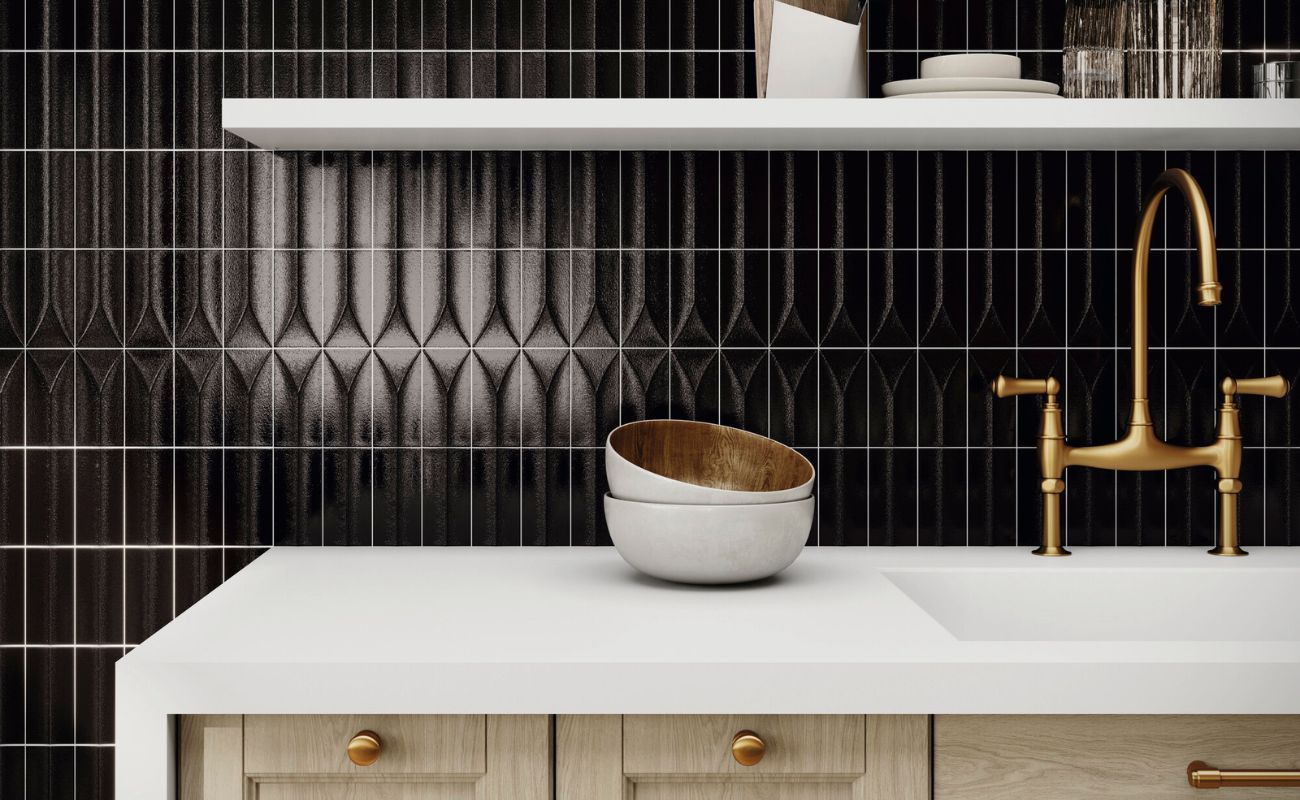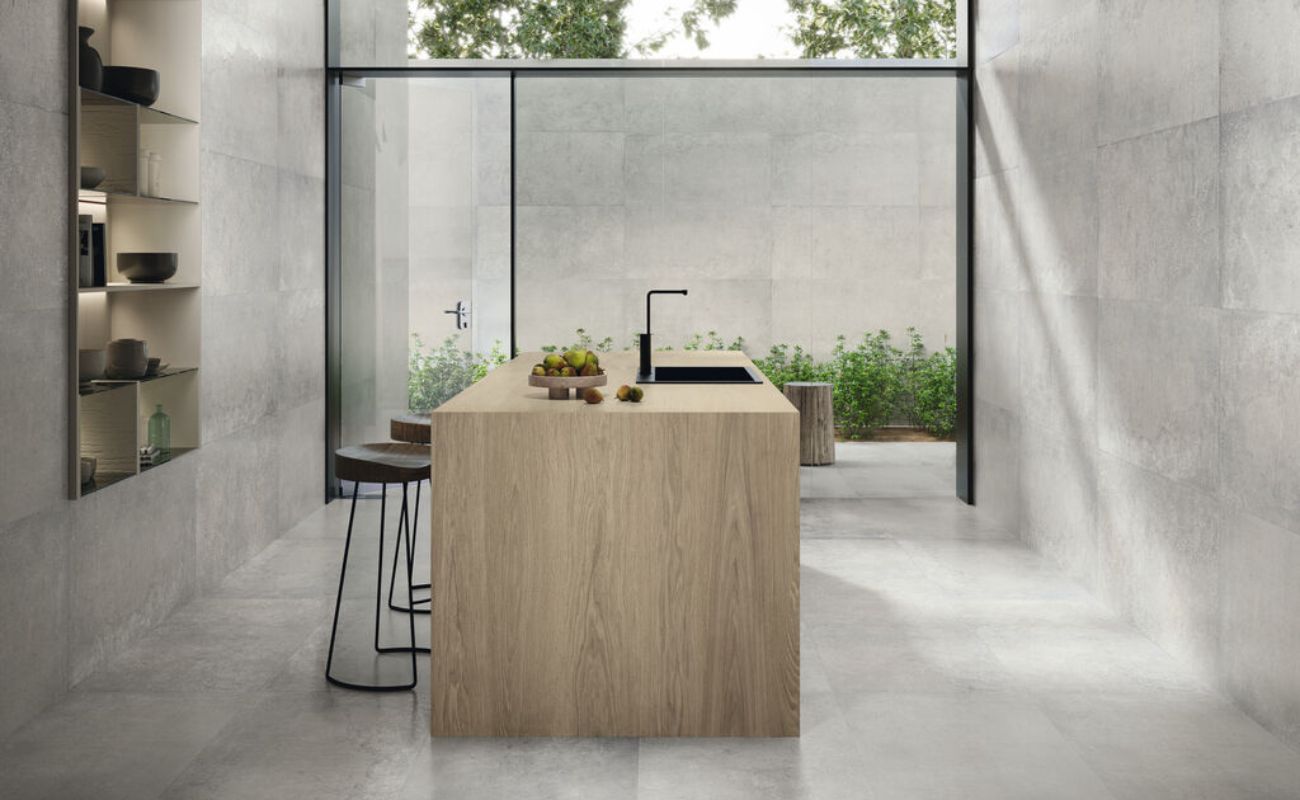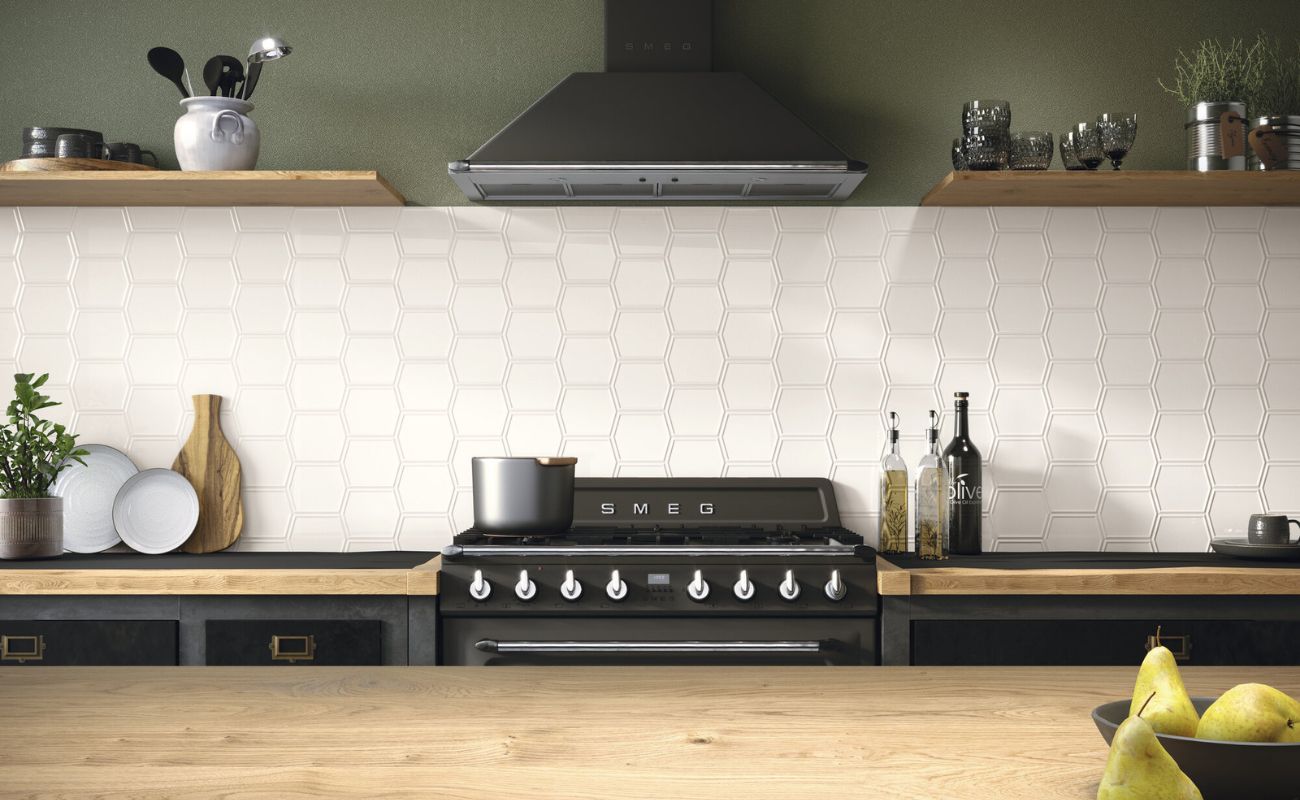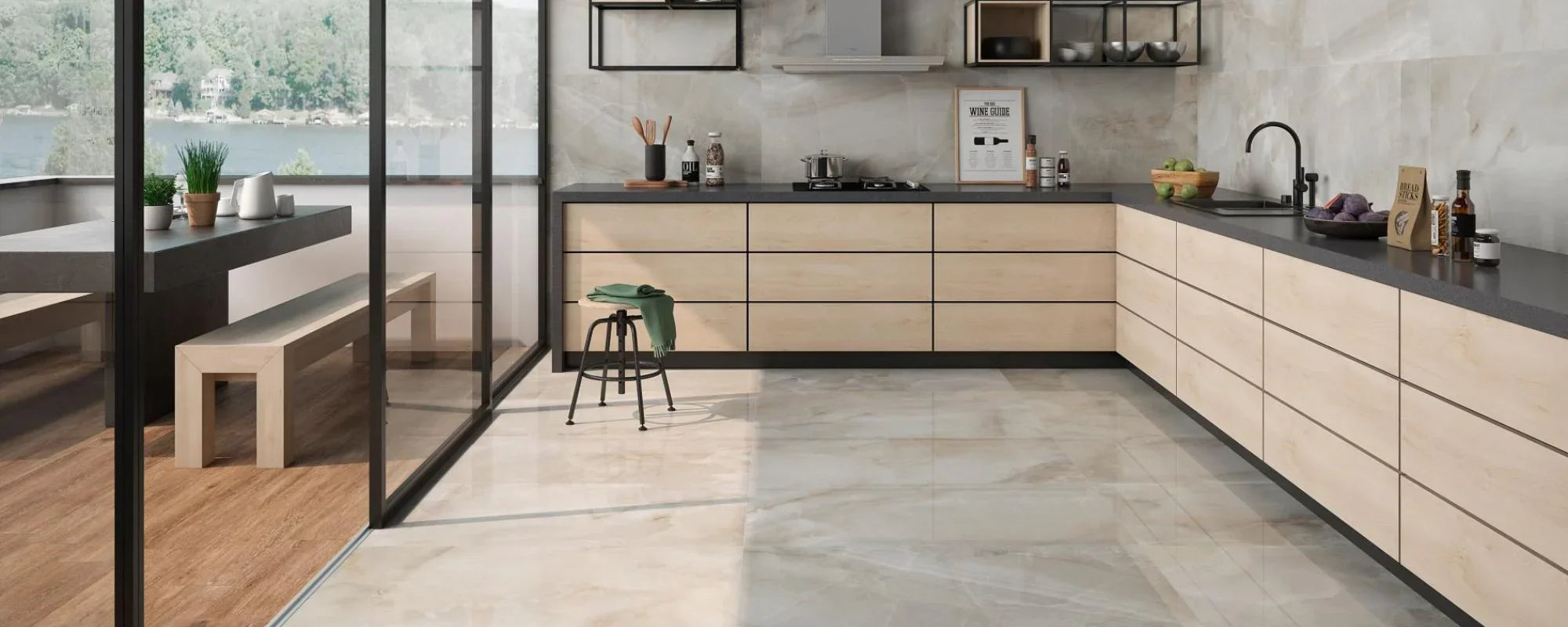
Kitchen Trends 2026: What’s Next for Tiles & Surfaces?
Written by: Halima Bapu
A New Era of Kitchen Design
As we move into 2026, kitchen design is embracing a warmer, more sensory direction, one that celebrates both the art and functionality of everyday living. The era of stark minimalism is softening; instead, we’re seeing kitchens evolve into deeply personal spaces filled with texture, natural materials, and layered light. This new wave of design champions a tactile, organic aesthetic where tiles and surfaces are more than practical foundations, they’re the heart of the space’s personality. Interior design as a discipline is driving this shift, influencing how kitchens are styled and experienced.
Interior designers are predicting a major shift toward earthy colour palettes, sustainable materials, and authentic finishes that balance form and function. Homeowners are increasingly embracing colour in their kitchens, moving towards bolder, warmer hues like ochres, terracotta, and deep greens in their cabinets . Think stone with visible veining, softly honed textures, and warm metallic details. The modern kitchen of 2026 is not just a room to cook in, but a sanctuary, one that embodies comfort, craftsmanship, and contemporary elegance, contributing to a more inviting and timeless house.
Layouts That Blend Function with Flow
Functionality remains at the core of kitchen design, but in 2026 it’s being redefined through a lens of fluid living. Open-plan layouts continue to dominate, yet designers are now finding creative ways to zone spaces using materials and surfaces rather than walls, helping to define a personalised and functional cooking space.
Kitchen islands are at the centre of this transformation, serving as sculptural anchors that connect cooking, dining, and social areas. Clad in statement tiles or seamless stone, these islands act as both practical workspaces and aesthetic focal points. Their forms are becoming bolder, monolithic shapes, layered surfaces, or combinations of stone and wood to balance warmth with structure.
Storage and cabinetry design follow the same principle of discreet functionality. Trending door styles—such as handleless, Shaker, or ribbed doors, are being used to achieve specific aesthetics, from minimalism to added texture and warmth. Sleek handleless units, integrated lighting, and hidden drawers create a calm, uninterrupted visual flow. The result is a kitchen that feels architectural yet lived-in, a balance of utility and artistry.

The Rise of Natural Materials and Tactile Textures
Materiality takes centre stage in 2026. Where previous years favoured polished perfection, the coming trend leans into imperfection and authenticity. Natural materials, wood, stone, clay, and terracotta, are being celebrated for their organic irregularities and the way they age gracefully over time.
Tiles are key to this look, and you can expect to see an influx of textured ceramics, hand-glazed finishes, and fluted surfaces . Expect to see an influx of textured ceramics, hand-glazed finishes, and fluted surfaces that bring subtle movement to walls and splashbacks. These tactile surfaces respond beautifully to light, changing tone and depth throughout the day. Incorporating these elements is essential for adding depth to kitchen design, introducing visual interest and a sense of dimensionality. Large-format porcelain tiles mimic the raw beauty of natural stone while offering unbeatable durability and ease of maintenance, ideal for modern family living.
Stone remains a cornerstone of kitchen design, but it’s being used in softer, more natural ways. Designers are opting for honed marble, brushed limestone, and travertine with visible fossilisation — materials that tell a story through their patterns and textures. The natural pattern found in these stones adds unique character and individuality to each kitchen. This return to authenticity creates a space that feels grounded, timeless, and effortlessly luxurious.
The Role of Interior Designers in Shaping Tomorrow’s Kitchens
Interior designers are at the forefront of shaping the kitchens of 2026, blending artistry with practicality to create cooking spaces that are both beautiful and highly functional. Drawing inspiration from leading publications like Elle Decor and insights from creative directors, designers are setting the tone for what’s next in kitchen design, championing the use of natural stone, wood, and other natural materials to infuse warmth, depth, and character into the heart of the home.
One of the most significant kitchen trends interior designers are embracing is the integration of natural stone, think marble, limestone, and travertine, into everything from countertops to statement backsplashes. These materials bring a sense of timelessness and natural variation, ensuring that each kitchen feels unique and full of life. Designers are also turning to patterned tiles, such as geometric motifs and chequerboard layouts, to add visual interest and a touch of artistry to kitchen tiles and splashbacks. While materials like Zellige tiles offer rich texture and depth, their chipped edges can present installation challenges. Here, the expertise of interior designers is essential, they know how to install these tiles to highlight their handcrafted beauty while ensuring durability and ease of maintenance.
The move toward warmer tones, such as terracotta, peach, and earthy neutrals, is another trend gaining momentum. Interior designers are skillfully layering these shades to create a sense of calm and connection, making kitchens feel inviting and lived-in. By incorporating natural materials and soft, layered lighting, they transform kitchens into spaces that radiate comfort and style. As one design director puts it, “A kitchen should feel like a warm hug, not a cold, sterile space.”
Customisation is key in the work of interior designers. They collaborate closely with homeowners to create cabinetry, drawers, and breakfast bars tailored to individual needs, ensuring that every element, from storage solutions to layout, supports daily life and personal style. This bespoke approach allows for the seamless integration of on-trend materials and patterns, while also delivering a sense of timelessness and authenticity.
Ultimately, interior designers are not just following trends, they are setting them, using their expertise to create kitchens that balance function, beauty, and a deep sense of connection. Their ability to interpret the latest styles, manage the complexities of installation, and understand the unique needs of each homeowner makes them essential partners in the journey to a dream kitchen. For those seeking more design inspiration or looking to create a kitchen that truly stands out, working with an interior designer ensures a space that is both on trend and deeply personal, a true reflection of the homeowner’s taste and lifestyle.

Tiles as the Soul of the Kitchen
Tiles have transcended their traditional role as simple splashback materials, in 2026, they are becoming statement-making design features. The trend towards tile-wrapped kitchen islands, floor-to-ceiling tiled walls, and decorative mosaic inlays brings artistry and craftsmanship into everyday spaces. The backsplash is now a key design element, with new materials like textured tiles, 3D hexagonal tiles, and slab stone adding visual interest, texture, and character to the kitchen.
Patterned tiles are also enjoying a renaissance. Geometric motifs, checkerboard layouts, and Japanese or Mediterranean-inspired designs are used subtly to create rhythm and visual depth. Rather than shouting for attention, these patterns whisper sophistication, often realised in muted tones of sage, sand, charcoal, or terracotta.
For those drawn to modern minimalism, large-format porcelain slabs are the trend to watch. Seamless and architectural, they create a monolithic effect across countertops, islands, and walls. The orientation of these tiles can dramatically change the perception of space depending on where you stand in the room, laying them lengthwise or widthwise from a doorway or main viewpoint can enhance the sense of openness. Their continuous surfaces reflect light gracefully and blur the boundaries between horizontal and vertical planes, enhancing the sense of openness.
Meanwhile, matte and textured finishes are overtaking glossy options. They feel natural under the hand and photograph beautifully, an important detail in our design-conscious, digital-first world. Tiles are no longer background elements; they define the entire aesthetic narrative of the kitchen.
The Colour Story of 2026: Earthy, Expressive, and Warm
Colour in the kitchen is getting richer, moodier, and more characterful. The neutral foundations that dominated the past decade are still relevant, but they’re now being layered with earthy undertones and expressive accent shades. Neutral tones, such as beiges, browns, and earthy shades, remain especially popular in kitchen design for their calming, versatile, and warm qualities, making them a go-to choice for cabinetry, tiles, and overall colour schemes.
Warm taupes, mushroom greys, and soft oat hues form the base palette, paired with accents of olive green, ochre, rust, and navy. These natural shades bring warmth and grounding, echoing the tones of the outdoors. For the bolder homeowner, 2026 welcomes deep jewel tones on cabinetry or tiled splash backs, creating contrast without overpowering the space.
Tiles and surfaces, along with innovative flooring, play a crucial role in balancing these palettes. Stone and ceramic finishes add depth and tactility, while subtle variations in tone make the space feel organic rather than overly designed. The modern kitchen is less about perfection and more about creating an emotional connection through material and colour harmony.
Flooring: Seamless Continuity and Natural Flow
Flooring in 2026 reflects a desire for cohesion, with several options trending for their blend of style and practicality. Designers are using a single continuous material across the floor and up the kitchen tiles, blurring boundaries and making spaces feel larger.
Natural stone flooring remains a timeless choice, with limestone, travertine, and marble offering a sense of enduring luxury. For those seeking practicality, porcelain stone-effect tiles are leading the way, combining resilience with hyper-realistic textures. These options are increasingly popular among homeowners for their durability and style.
Wood and wood-look tiles continue to bring warmth and texture underfoot, with new collections offering rich grains and sustainable sourcing. Many homeowners are also embracing herringbone layouts or mixing materials to define zones — such as pairing timber planks with tiled prep areas for both aesthetic and functional distinction.
Lighting, Fixtures, and Finishing Details
Lighting has become the most transformative tool in kitchen design. In 2026, it’s about sculptural elegance and ambient layering. Pendant lights in textured glass or brass add warmth above islands, while recessed LED strips trace the contours of cabinets and splashbacks, highlighting the depth of stone or tile surfaces.
The trend toward warmer lighting temperatures (2700K–3000K) continues, creating an inviting glow that enhances the natural hues of materials. Fixtures are leaning toward tactile finishes, brushed nickel, aged bronze, and matte black, which compliment both rustic and contemporary schemes.
These finishing touches elevate the tactile narrative of the kitchen, as if writing a story that ties together surfaces, colour, and light into one cohesive sensory experience.

Functionality and Accessibility in the Modern Kitchen
The modern kitchen is redefining what it means to be both beautiful and practical, with functionality and accessibility taking center stage in 2026. Interior designers are reimagining cooking spaces to ensure they are as easy to use as they are visually stunning. This means layouts that prioritise smooth movement, with wide walkways and thoughtfully placed work zones that make daily life in the kitchen effortless.
Natural materials like natural stone and wood are being used not just for their beauty, but for their ability to add warmth and depth to the cooking space. Kitchen tiles, especially patterned tiles, are increasingly popular for creating zones and adding character without sacrificing accessibility. Designers are opting for countertops at comfortable heights and incorporating wide drawers that glide open with a touch, making it easier for everyone to access essentials.
Accessibility is also about inclusivity, ensuring that kitchens work for all ages and abilities. This trend is reflected in the rise of pull-out shelves, touch-activated faucets, and easy-to-reach storage solutions. The result is a kitchen design that feels open, inviting, and tailored to the needs of modern homeowners. As interior designers continue to innovate, expect to see more kitchens that seamlessly blend natural materials, functional layouts, and accessible features, creating spaces that are as welcoming as they are on trend.
Personalised Spaces: Kitchens Tailored to You
Personalised spaces are at the forefront of kitchen design in 2026, as homeowners seek to create kitchens that are a true reflection of their individual style and daily life. Interior designers are responding with creative layouts, bold colors, and a mix of natural materials that make each kitchen unique. From statement breakfast bars to custom cabinetry, every detail is an opportunity to infuse personality and warmth into the heart of the home.
The use of natural stone, wood, and kitchen tiles, especially patterned tiles, allows for endless customisation. Warmer tones and layered textures are increasingly popular, helping to create a kitchen that feels both inviting and on trend. According to leading creative directors and design directors, embracing color and experimenting with new materials are key kitchen trends for 2026. Homeowners are encouraged to play with bold hues, creative layouts, and distinctive finishes to craft a space that suits their lifestyle and aesthetic preferences.
Functionality and accessibility remain essential, with features like easy-to-reach cabinets, countertops at ergonomic heights, and smart storage solutions ensuring that personalised kitchens are as practical as they are beautiful. Interior designers are adept at balancing these needs, using their expertise to create kitchens that support daily routines while expressing the homeowner’s unique taste.
Natural materials continue to be a cornerstone of kitchen design, adding depth, warmth, and a sense of timelessness. Whether it’s a dramatic stone countertop, a wood-clad breakfast bar, or a splash of color from patterned tiles, these elements help create a kitchen that stands out and feels truly personal.
As kitchen trends evolve, the modern kitchen is becoming a space where creativity, comfort, and individuality shine. By embracing bold colors, innovative layouts, and the enduring beauty of natural materials, homeowners can create kitchens that are not only functional and accessible but also deeply personal and inspiring.

Sustainability and Smart Design Integration
Sustainability is no longer an optional feature, it’s the new standard for luxury. Homeowners and designers are seeking materials that are both eco-conscious and enduring. Recycled porcelain, responsibly quarried stone, and low-VOC adhesives are becoming mainstream. Surfaces are selected for longevity and low maintenance, ensuring beauty that lasts decades, not just seasons.
Smart design also continues to advance, though quietly. Integrated induction hobs, built-in charging drawers, and voice-controlled lighting systems are subtly embedded within natural materials, merging technology with craftsmanship. The future kitchen is intelligent yet soulful, powered by innovation, grounded in beauty.
Hardware and Accessories: Subtle Statements
While cabinetry and tiles take centre stage, hardware and kitchen accessories are becoming essential for adding character and finishing touches. In 2026, designers favour slim, sculptural handles and knobs with rounded edges in finishes like aged brass, brushed nickel, and matte black. These choices complement the warm, tactile materials and add understated elegance without overpowering the space.
Similarly, breakfast bars are gaining popularity as functional and social hubs. They often feature painted cabinetry in warm tones and are paired with comfortable seating, making them an essential part of daily life in the kitchen.
Embracing Small Appliances with Smart Storage
A key element of the 2026 kitchen is the clever integration of small appliances without cluttering the space. Homeowners increasingly prefer hidden storage solutions such as appliance garages and pull-out drawers to keep countertops clean and maintain the calm, sleek aesthetic.
This approach not only enhances the kitchen’s visual appeal but also improves functionality, making daily cooking and entertaining effortless.







